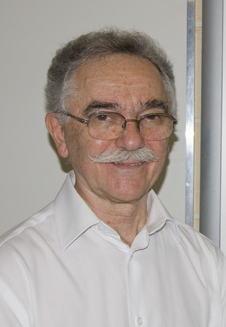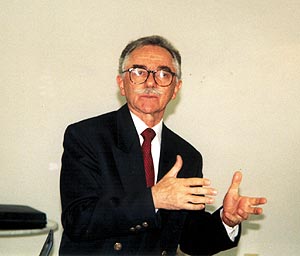Guia de referência sobre a cultura da Netflix
6 de agosto, 2009Which one is the right product to invest?
6 de setembro, 2009I believe this will be one of my longest posts but the topic really deserves a lot of attention.
Two weeks ago I had the opportunity to talk to Mr. Clóvis Bojikian. He was Semco‘s HR director since early 1980’s. He worked with Ricardo Semler in the implementation of the participatory management framework that made Semco one of the most famous successful Brazilian company in the world.

1. Setting context – Semco
Clóvis started giving some context. Fisrt, about Semco, already a successful company 25 years ago.

Their main product was naval hydraulic pumps. The main concern was diversification away from the struggling shipbuilding industry, which was done through:
- new licenses: in order to produce and commercialize other products such as mixers and agitators.
- acquisition of Brazilian companies from multinationals: refrigerators and cleaning machines are examples.
- joint ventures: that’s how Semco entered into services business. Industrial maintenance, buildings conservation, inventories are some examples.
In 20 years the company grew from 300 to 4000 employees.
2. Setting context – Clóvis Bojikian
Clóvis master was in pedagogy. Some time later he studied business administration.

He first worked as director of the “Colégio de Aplicação da USP” an experimental school very famous during the 60’s where new teaching methods were experimented. One of the most advanced schools of its time. He left due to some pressures during the military dictatorship started in 1964. He then joined Ford, at the time with 4,000 employees, as HR manager. Ford was acquiring Willys, a 16,000 employees car maker. There was little freedom for the HR professional to work (“in a wining team no one wants to makes changes”) so he decided to leave and joined KSB Hydraulic Pumps where he was able to try out some ideas he has. But due to a CEO change, the freedom diminished. At that time, Clóvis went to talk with Ricardo Semler, “many hours of conversation” as Clóvis pointed out. Ricardo was only 22 years old at the time and just assumed as CEO of Semco. He was looking for an HR professional who could help him implement the participatory management concepts he was thinking about. Clóvis, 48 years old, loved this conversation and the synergy with Ricardo and decided to accept the responsibility to run Semco’s HR.
3. The roots of participatory management
Semco is a factory and, as any other factory, workers didn’t enjoyed going to work. Every week they counted the hours until the next weekend. That was Clóvis’ main challenge: “how do we get people motivated?” Some simple facts:
- No one motivates anyone.
- Motivation comes from the person.
- We need to create conditions so people can feel motivated.
- The people who demonstrated more interest in the work were the ones “in charge”.
And one simple conclusion:
are the ones who participate more.
That was easy to understand. The ones “in charge” are the people who participate more in the business making decisions and watching the results of their decisions. More participation means more interest and more motivation.
4. Exercising participation
In order to exercise participation Clóvis recommended simple, non core business related situations. He gave two examples from Semco:
Employees restaurant: employees normally complained about the restaurant to the HR people. Normally the complain was documented and analyzed by the HR but not always an action was taken. One day the Hr decided to return the complain in a question: “what would you do to change it?”. The complainers got dazzled and, by recommendation of the Hr people, they formed a commission to study what could be done better. The commission end up wit very good ideas, and came back to the HR people who asked: “did you talk to the restaurant people about your suggestions?” and they didn’t. They went to the restaurant, discussed the suggestions, and again they came back to the HR people who just said: “ok, move forward and implement your suggestions”. Since then, the restaurant was run by the restaurant, with support of the employee commission, with no interference of the HR people.
Employees uniform: the stock of employees uniform was running low and a new purchase was due. Instead of just placing an order with the supplier for more uniform, they decided to run an election with employees so they would decide the color of the uniform. Some directors didn’t like the election idea because it would take time and probably would be a mess, but the fact that the democracy was being exercised in a non core business related situation gave run for the experiment. Two colors come very close at the end of the election, and the employees themselves proposed to run a second election, only with those two colors. Finally one was chosen.
As Traci Fenton, from WorldBlu, mentions:
We are talking about distributing leadership, distributing decision making in a way that makes sense. So maybe, the decision making process can sometimes, depending, be slower. But execution is so much faster. And the reason it is faster is because people have a buy-in, because they have been a part of the decision. They have ownership in that decision. They wanna see it succeed. and that’s what make execution so much faster. And that’s were most of the companies fail, on the execution.
5. The next step – closer to the core
Some time later, the employees started to decide their own production targets, and they were normally higher than the ones defined previously by t the executives.
This shows how, when we start exercising participatory decision making with non core business related issues, it is easy, even natural to start moving into more core related decisions.
In Brazil there are holidays on Tuesdays, Wednesdays and Thursdays that people like to connect to the weekend so they have a longer holiday. Normally is the company decision to define who will connect the holiday and who will work on that holiday to compensate a previous holiday connection. After participatory decision making process was experienced the employees themselves decided on the holiday connections.
The next step at Semco was the design of the new roles, responsibilities and compensation plan. It was completely written by the employees with the facilitation and help of the HR people. When the plan was finally implemented, not only everybody knew everybody else’s salaries, but everybody understood why those salaries were paid and were in total agreement with that.
Another interesting example of participatory decision making was the hire of a new manager. Instead of being interviewed only by the HR people and the demanding director, the manager was also interviewed by other managers and by the team he or she would lead. The chosen manager had a great start, since he was not only known by his or her director but also by all the people he or she would work with. Semco also used 360 evaluations in order to have employees analyzing their leaders.
All issues were dealt with by temporary groups.
In order to let employees understand more of the whole business, they decided to change from assembly lines to small cells responsible for the whole piece.
At that point Semco had a framework of participatory management and decided to move to the next step.
6. The final step – a stake in the results
And Semco was ready for the final step, profit sharing. The owners decided to give twenty something percent of the profit to the employees and all the rest was decided in a participative manner. The employees created a set of principles. One of the main principles read more or less like this: “It is not enough to be transparent, we need to educate”. The idea is that not only all numbers of the company be open to all employees but all the employees must be trained to be able to read those numbers. Income statement, P&L and cash flow require some background in order to be read and understood. This is the basis of the Open Book Management:
- Give employees training to understand the financial information.
- Give employees all relevant financial information
- Give employees responsibility for the numbers under their control
- Give employees a financial stake in how the company performs
Every month they run a meeting at Semco to discuss results and some very interesting situations happened during those meetings. One day an employee questioned why the executives had to always stay in five star hotels. Wouldn’t it be possible to stay at four stars hotels once in a while? At another monthly report review another employee noticed that Semco spent money on painting the factory in a month that the employees had some free time and they could have painted the factory themselves.
At that point Semco implemented flexible hours and flexible workplace, even allowing work to be done from home. Now that everybody has a stake in company success it is possible to implement such a policy. Of course it should be adopted where it makes sense. For instance, it doesn’t make sense for a receptionist to work from home. But if there are two receptionists to cover a certain amount of time, they could and should decide among themselves when each one should be there.
7. Conclusions
At end of our conversation, Clóvis mentioned that it only takes courage to implement participatory management in a company. Errors will happen and we should learn from them, but the end result, a company full of employees happy to come to work everyday is worth all the risks.
I asked him to tell us about an error or a moment they thought that maybe this whole participatory decision making process could not be a good idea.
He told us a very interesting story about the payroll time clock system. All employees had to checkin when arriving to work, checkout and checkin during lunch and then checkout again at the end of the work day. But this was a control for what is regular, and what a company really needs to know is what is irregular (extra hours, delays, absences). HR decided to change the time clock system so the employee only had to inform extra hours, delays and absences. And what was most important, the employee should inform directly into the system. She didn’t need to explain anything to her boss. The first month everything went quite well, but in the second month there were frauds, people were not informing the working hours irregularities correctly. They were taking advantage that no one was checking the information. Very concerned, the HR people discussed the issue with a group of employees who were in charge of this new system. The answer was: “leave it to us”! After that conversation the system worked very well with no frauds ever reported or noticed. Clóvis mentioned that the employees understood that “the more freedom we have, the more responsible we have to be”, and they acted accordingly.
